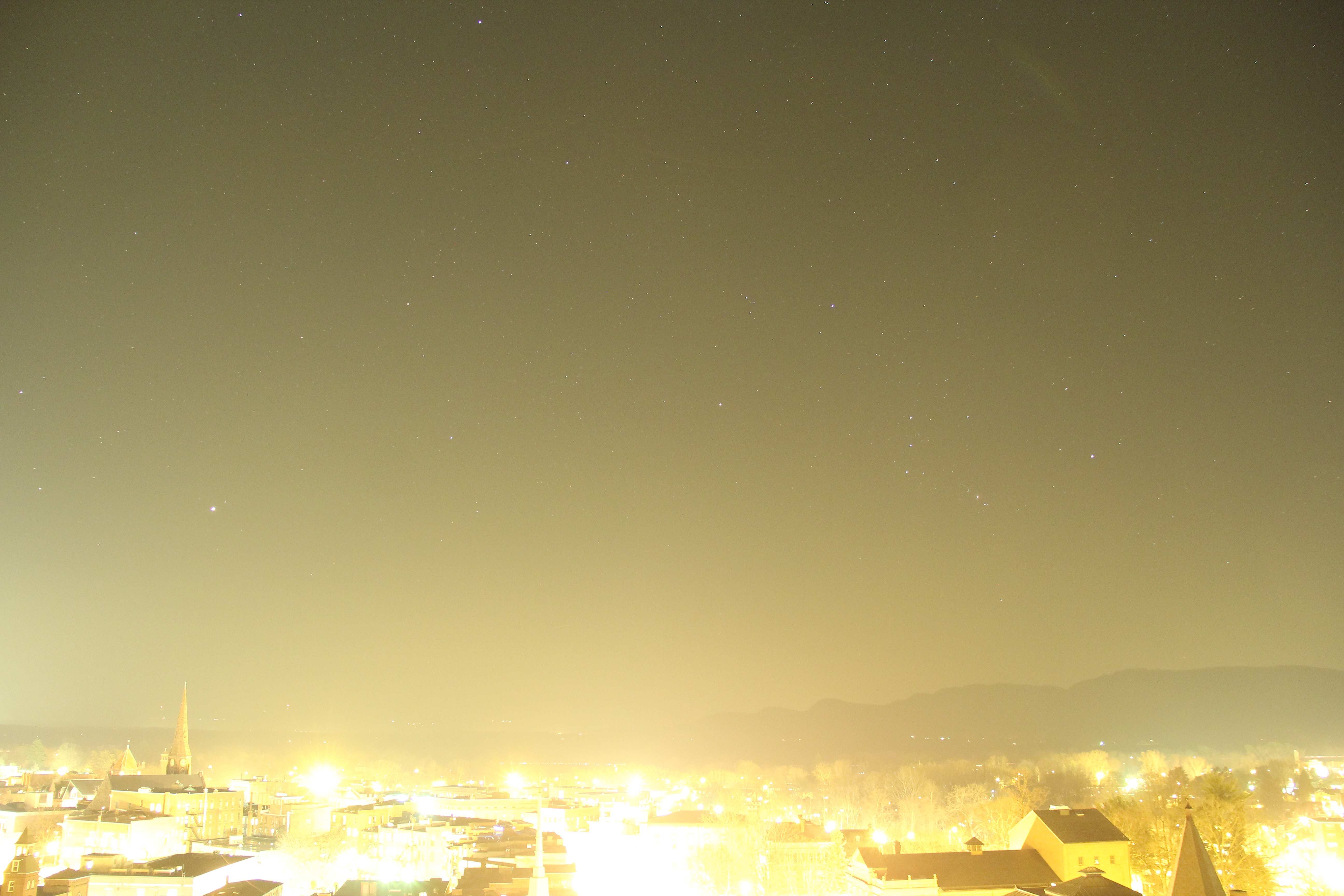
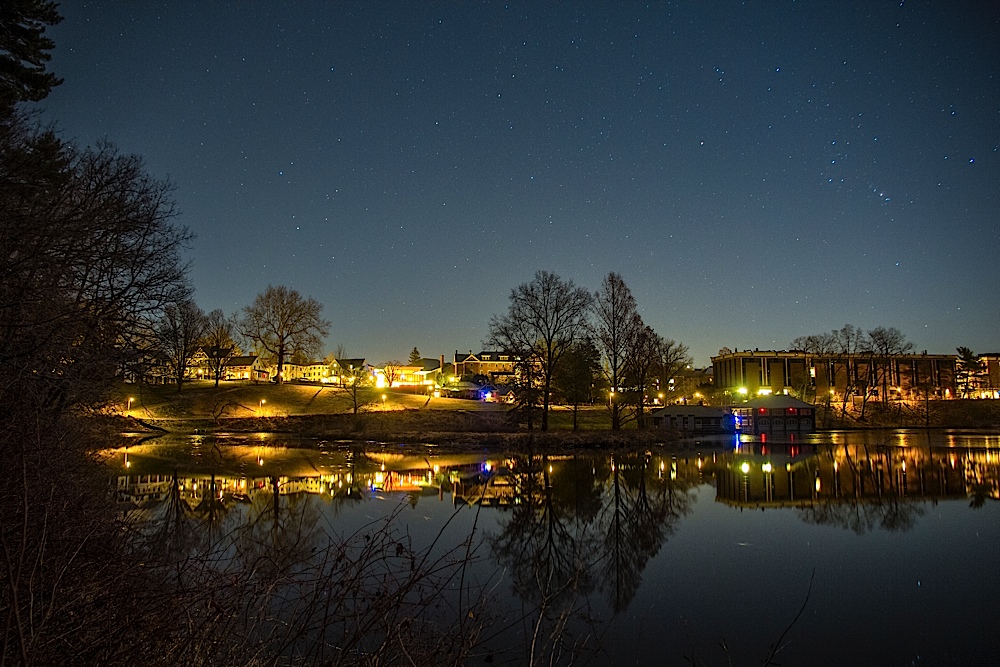
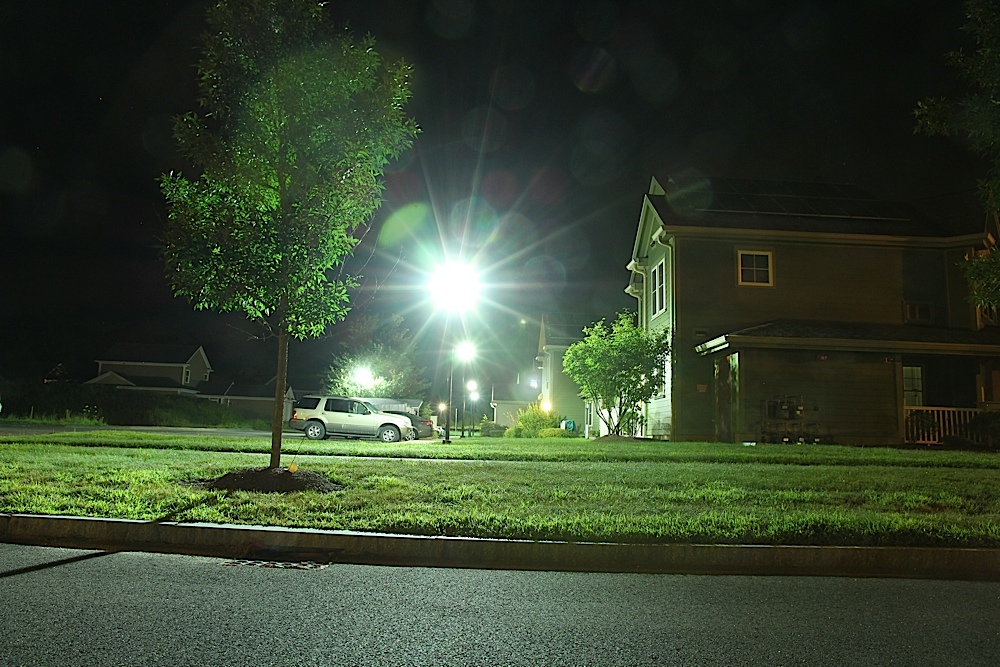
What is light pollution?
Light pollution is the artificial brightening of the naturally dark night sky due to excessive and poorly designed outdoor lighting.Why is light pollution a problem?
- Public health: Light pollution and excessive blue-rich light at night are associated with
- Suppression of melatonin, an important hormone
- Disruption of circadian rhythms, or natural sleep cycles
- Elevated rates of diabetes, obesity, breast cancer, and prostate cancer
Here is a report from the American Medical Association on the “Human and Environmental Effects of Light Emitting Diode Community Lighting".
- Public safety
- Wildlife
- Energy and climate change
- Historic preservation and quality of life
Streetlights and other outdoor lights that cast their light widely also cause glare -- unwanted light that shines directly in your eyes. This is dangerous for drivers, pedestrians, and bicyclists. Glare has particularly strong effects on the elderly. Glare is especially strong from LEDs, and especially blue-rich white LEDs. If the light is shining in your eyes, you can't see anything else!
Lights that are poorly shielded against glare also tend to cause dark shadows that can easily hide intruders.
All animals -- insects, birds, and mammals including humans -- evolved with a 24-hour day-night cycle. Humans and other diurnal animals need complete darkness to sleep. The feeding, mating, and migration patterns of nocturnal animals can be seriously disrupted by light pollution; some species of birds, turtles, and fireflies are threatened with extinction due largely to light pollution.
Light pollution is pure waste. Billions of dollars per year are spent by US cities and states lighting up the sky, without even meaning to. Generating the electricity to power that light pollution produces millions of tons of CO2 per year, contributing significantly to the nation's total greenhouse gas emissions.
Historic cities and towns like Northampton, MA, founded in 1654, deserve well-designed outdoor lighting that enhances their beauty and charm -- not harsh, over-bright, unshielded, blue-rich white lights that make our downtowns feel like prison yards. The US National Park Service considers the naturally dark star-studded sky a natural resource, like clean air and water, that should be preserved for everyone.
And we need to see the stars! Most children growing up in the US today have never seen the Milky Way. There is growing concern about "nature deficit disorder," especially among city kids. The starry sky and the Milky Way are a priceless gift of nature that should be accessible to all.
Isn't light pollution a necessary evil to keep our cities safe from crime?
Absolutely not! Bad outdoor lighting -- too bright, too blue, and too spread out -- benefits no one, except maybe criminals who take advantage of dark shadows caused by glare. Decades of scientific research have failed to find a conclusive link between outdoor lighting and crime. Some very brightly-lit cities have terrible crime problems, while other cities with more subdued lighting have low crime rates. To make our cities safer, we don't need more light -- we need better light.
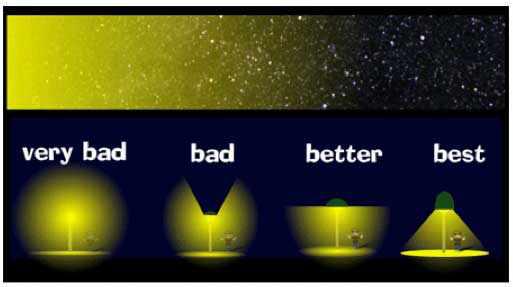
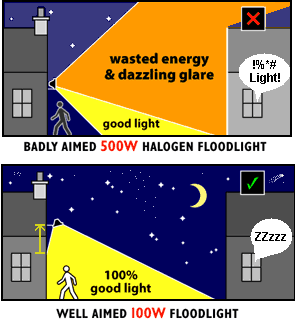
What can I do to prevent light pollution?
Follow these five rules for outdoor lighting produced by IDA and IES:
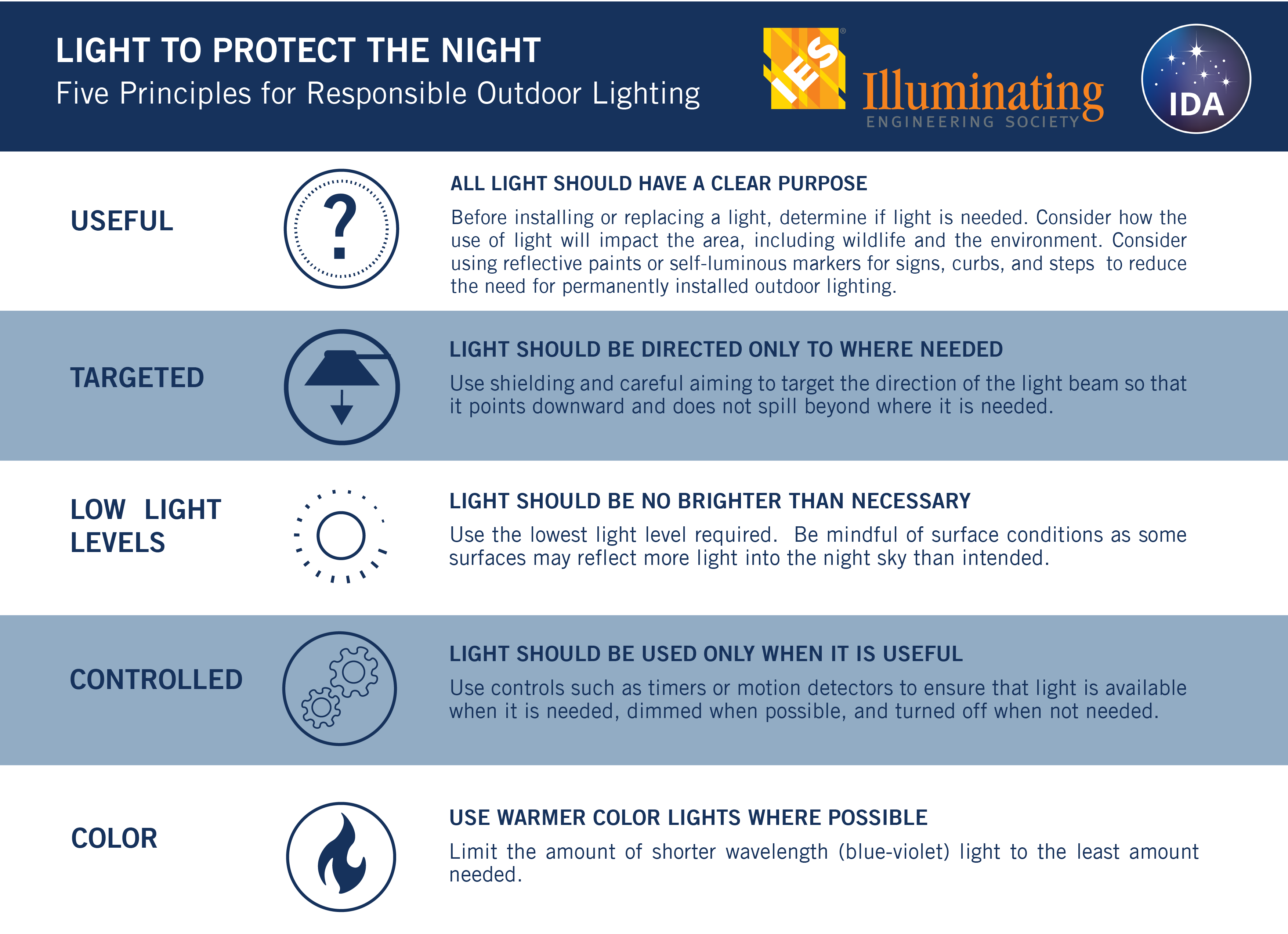
Contact your mayor, city councilor, select board, or other elected officials to demand that your city's outdoor lights comply with all five of those rules!
Here's an outdoor lighting audit you can bring to your neighbors or businesses with problem lights (also available in MS Word).
Here's a before/after comparison of old high-pressure sodium vs. new LED streetlights in Northampton, MA.
Are there laws governing outdoor lighting?
Yes. For example, Northampton has an ordinance requiring all outdoor lights to be shielded against glare and light trespass, so that no light shines on neighboring properties.
Here is the Model Lighting Ordinance developed by the International Dark-Sky Association and the Illuminating Engineering Society. Bring this to your city's planners if you don't have a good dark-sky ordinance in place.
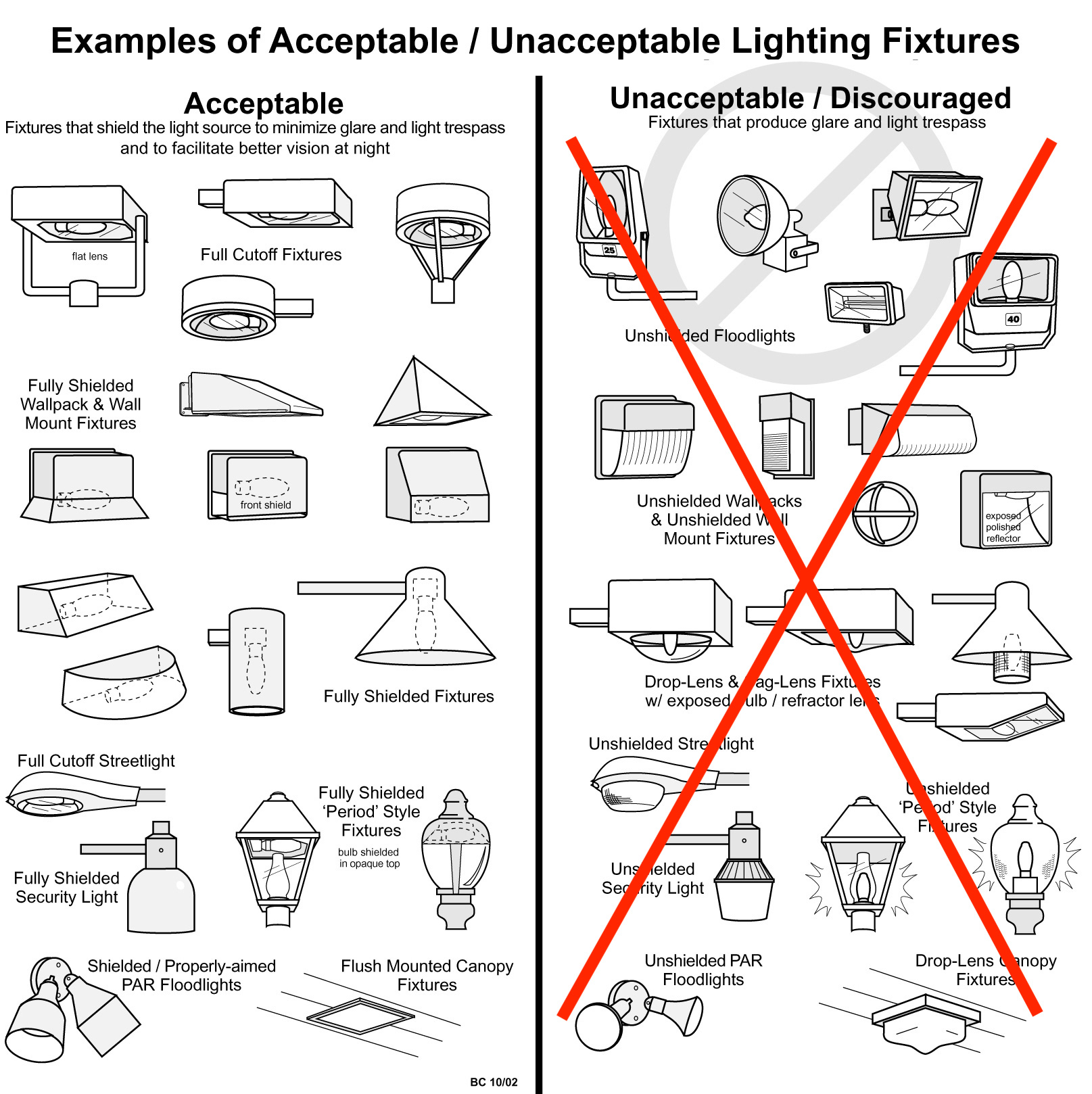
TV and Radio Interviews, Talks, and Appearances
- What Happened to the Milky Way? Talk (by Zoom) at Historic Northampton, Mar 29, 2022
- Protecting Dark Skies Talk (by Zoom) at Sierra Club Massachusetts Advocacy Hour, Mar 9, 2022
- It's Nighttime -- it's
Supposed to be Dark! Talk (by Zoom) at Lexington Living Landscapes, 24 Feb. 2022 - Like Moths to the Flame: Pollinators Need Dark Nights Talk (by Zoom) at Lincoln Land Conservation Trust, Jan. 13, 2022
- 'Erosion', interview by Vanessa Lowe for her Nocturne podcast, published 2021 Nov. 10
- "It's night time -- it's supposed to be dark!" -- talk Aug. 18, 2020 to Western Massachusetts Pollinator Network
- Who Owns the Night Sky? Science Friday with Ira Flatow (NPR): 2020 Jul. 10
- "Satellite Mega-Constellations and the Night Sky: OIR Visibility, Impacts, and Policy", invited plenary talk at American Astronomical Society meeting #236, June 2020 (requires AAS login)
- Radio interview by Salman Hameed on Starlink satellite megaconstellation, WHMP's Bill Newman Show, Dec. 4, 2019 (starts at 43:50)
- Light Pollution and Health Concerns, WGBY Connecting Point interview with Carolee McGrath, 2019 Sep. 03
- "Astronomers Worry How 'Swarms' Of SpaceX Satellites Will Impact Science, Nature" Radio interview by Kari Njiri, WFCR/NEPR, Nov. 20, 2019
- BBC radio interview, Nov. 15, 2019 (dead link)
- Presentation with Leo Smith to Springfield, MA City Council's Green Committee, 2018 March 28.
- Radio interview by Larry Hott, the Bill Newman Show, WHMP, 2018 Jan. 24 (clip starts at 39:00 minute mark)
- City Lights, Beautiful Nights TEDx Springfield talk, 2016 Oct. 9
- TV interview 2015 Dec. 01, by Mutsumi Takahashi on CTV Montreal
Print media interviews and quotes
- "The Pentagon is looking for garbage collectors in space", by Christian Davenport, Wall Street Journal, 2022 Feb. 02
- "Light Pollution Threatens Millennia-old Indigenous Navigation Methods", by Nikita Amir, Discover Magazine, 2021 Oct. 27
- "As SpaceX Launches 60 Starlink Satellites, Scientists See Threat to ‘Astronomy Itself’", by Shannon Hall, New York Times, Nov. 11, 2019
- Light’s dark side: How light pollution affects western Massachusetts, by Greta Jochem, Daily Hampshire Gazette, 2019 June 11
- Clearing a path to the stars by Laura Dattaro, Symmetry Magazine, 2017 Sep. 12
- Bright idea? Light pollution fears shadow NCC plan to light up capital by Gabriel Roy, Ottawa Citizen, July 28, 2017
- Your self-driving car could kill radio astronomy by Daniel Clery, Science Magazine, 2017 Jan. 20
- Northampton streetlight shields sought by Amanda Drane, Daily Hampshire Gazette, 2016 July 05
- Petitioners say Northampton LED streetlights too bright by Chris Lindahl, Daily Hampshire Gazette, 2016 May 21
- Montreal's push for outdoor LED lights isn't just a night-sky problem. It's unhealthy, scientists warn by Gabriele Roy, Montreal Gazette, 2016 Feb. 5
- Humans cling to their primal fear of the dark by Eric Betz, Astronomy Magazine, 2015 July 29
Letters to the Editor and Opinion Pieces
- "Space as an Ancestral Commons" in Nature Astronomy, Nov. 2020
- "A starry night can soothe the soul" Daily Hampshire Gazette, 2020 Apr 27
- "Northampton needs an outdoor lighting committee" Daily Hampshire Gazette, 2019 May 6
- Cites concerns about LED outdoor lighting Daily Hampshire Gazette, 2017 Nov. 29
- Criticizes city’s approach on LED streetlights Daily Hampshire Gazette, 2016 October 24
- City has better streetlight choices Daily Hampshire Gazette, 2016 June 11
Reports
- UN/IAU/IAC "Dark and Quiet Skies 2" online conference and report, October 2021, and Working Paper to UN COPUOS STSC, Jan. 2022
- SATCON2 workshop Executive Summary, Working Group Reports, and Community Engagement Working Group report to National Science Foundation on impacts of satellite megaconstellations on astronomy, Jul. 2021
- UN/IAU/IAC "Dark and Quiet Skies" conference and report, WG draft reports, BioEnvironment WG draft report, and video of BioEnvironment session to United Nations Committee on Peaceful Uses of Outer Space, Jan. 2021
- SATCON1 workshop and report to National Science Foundation on impacts of satellite megaconstellations on astronomy, Aug. 2020
More light pollution links
- International Dark-Sky Association (IDA)
- IDA Massachusetts Chapter
- Northampton City Lights
- Datastream from TESS Stars4All dark-sky photometer at McConnell Rooftop Observatory, Smith College
- Smart Outdoor Lighting Alliance
- Backlighting, uplighting, and glare (BUG) rating description
- "The End of Night", book by Paul Bogard
- City Dark film
- Mont-Megantic Dark Sky Reserve (Quebec, Canada)
- Dark Site Finder
- Dark Sky Map
- Interactive Light Pollution Map